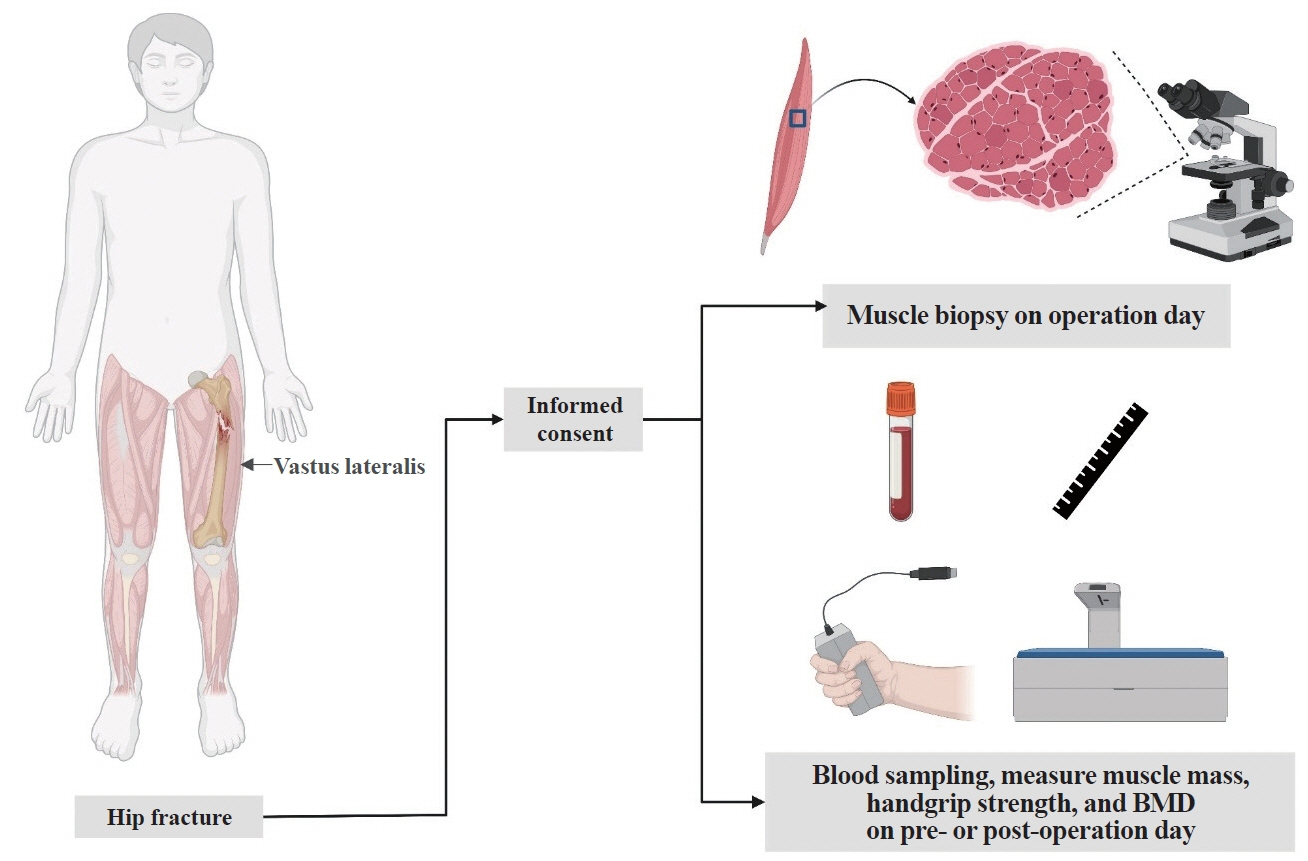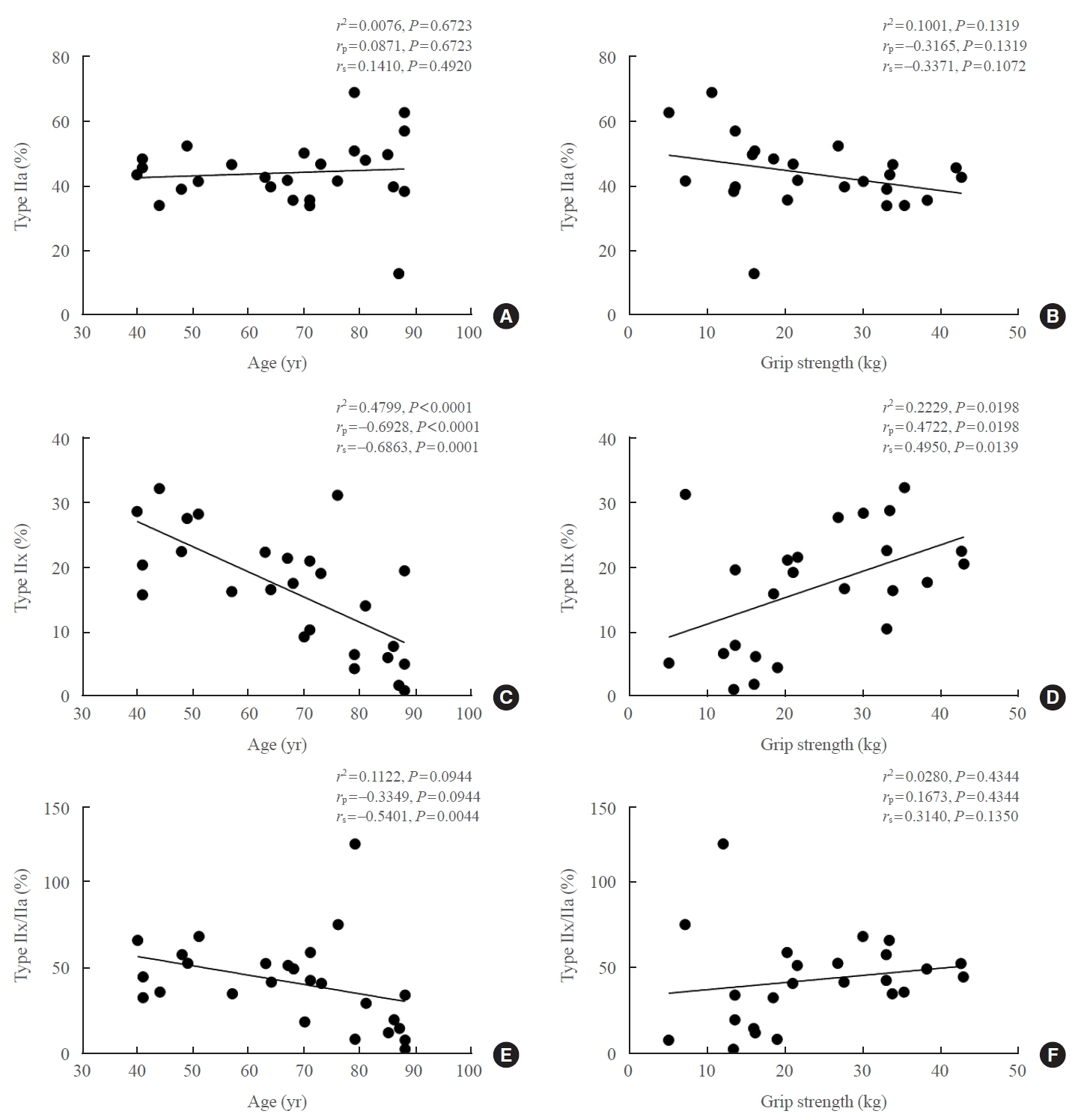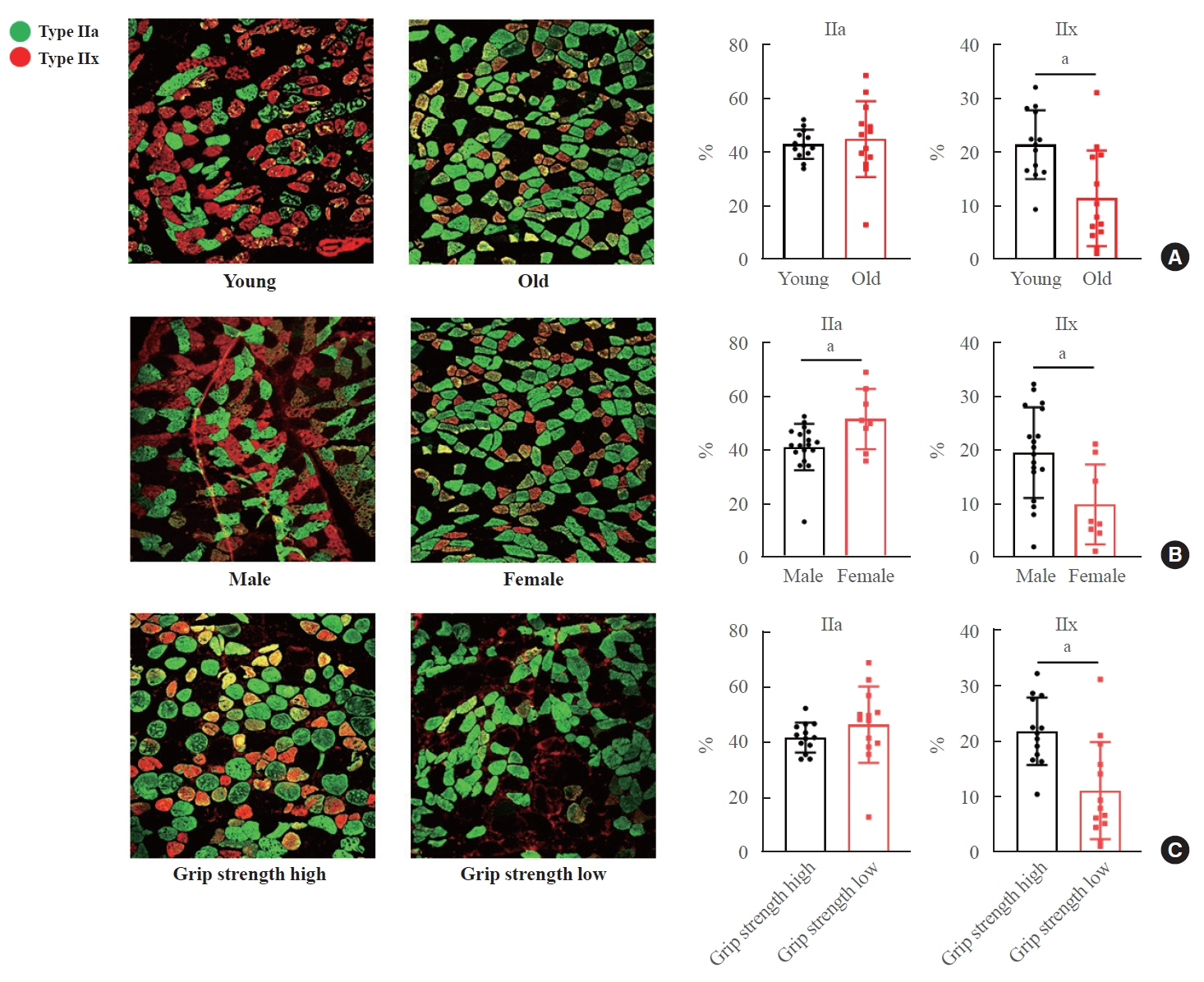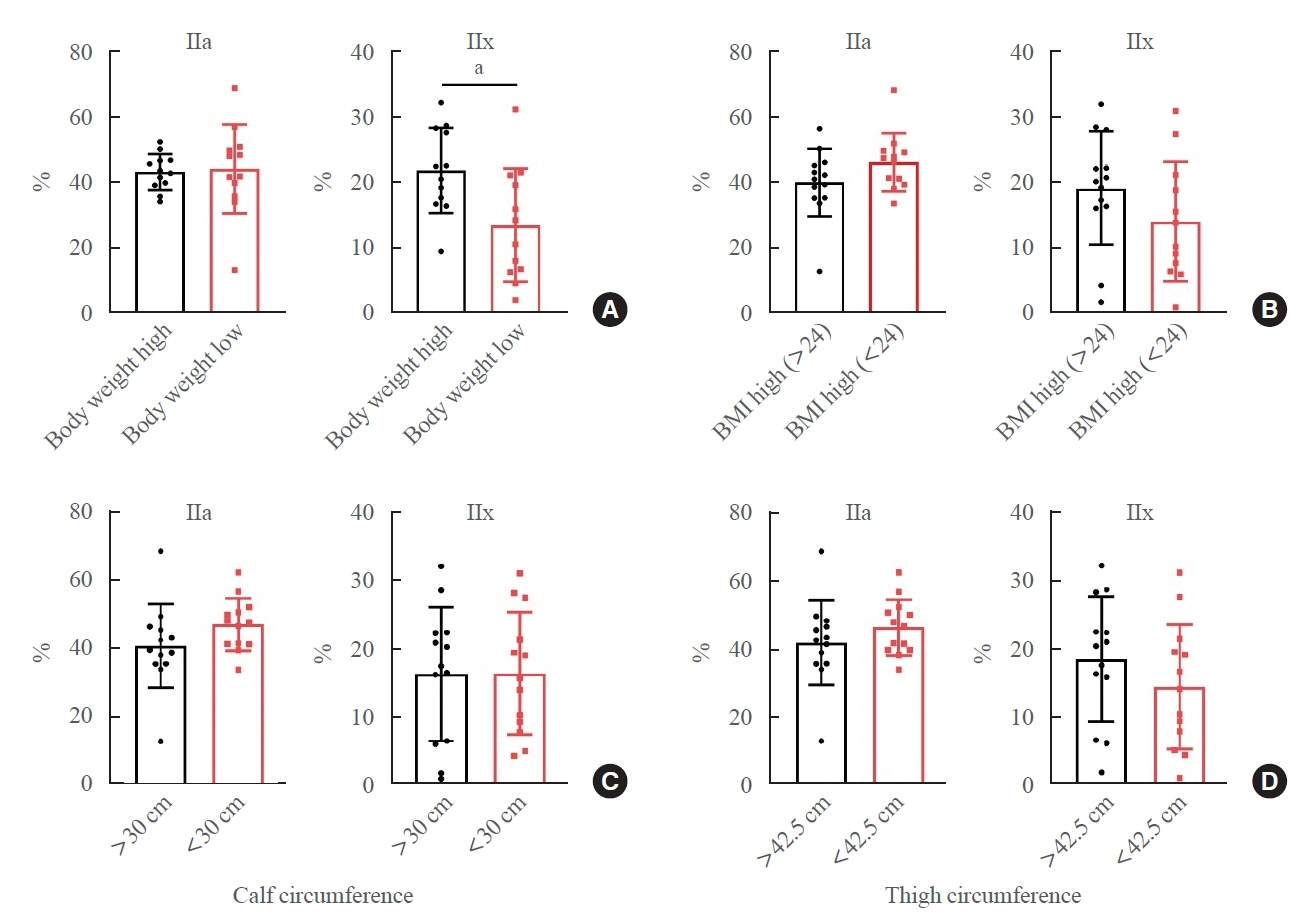Endocrinol Metab.
2024 Jun;39(3):521-530. 10.3803/EnM.2024.1935.
Differences in Type 2 Fiber Composition in the Vastus Lateralis and Gluteus Maximus of Patients with Hip Fractures
- Affiliations
-
- 1Laboratory of Endocrinology and Immune System, Chungnam National University College of Medicine, Daejeon, Korea
- 2Department of Medical Science, Chungnam National University College of Medicine, Daejeon, Korea
- 3Department of Internal Medicine, Chungnam National University College of Medicine, Daejeon, Korea
- 4Department of Orthopedics, Chungnam National University Hospital, Daejeon, Korea
- KMID: 2556644
- DOI: http://doi.org/10.3803/EnM.2024.1935
Abstract
- Background
Aging leads to sarcopenia, which is characterized by reduced muscle mass and strength. Many factors, including altered muscle protein turnover, diminished neuromuscular function, hormonal changes, systemic inflammation, and the structure and composition of muscle fibers, play a crucial role in age-related muscle decline. This study explored differences in muscle fiber types contributing to overall muscle function decline in aging, focusing on individuals with hip fractures from falls.
Methods
A pilot study at Chungnam National University Hospital collected muscle biopsies from hip fracture patients aged 20 to 80 undergoing surgical treatment. Muscle biopsies from the vastus lateralis and gluteus maximus were obtained during hip arthroplasty or internal fixation. Handgrip strength, calf and thigh circumference, and bone mineral density were evaluated in individuals with hip fractures from falls. We analyzed the relationships between each clinical characteristic and muscle fiber type.
Results
In total, 26 participants (mean age 67.9 years, 69.2% male) were included in this study. The prevalence of sarcopenia was 53.8%, and that of femoral and lumbar osteoporosis was 19.2% and 11.5%, respectively. Vastus lateralis analysis revealed an age-related decrease in type IIx fibers, a higher proportion of type IIa fibers in women, and an association between handgrip strength and type IIx fibers in men. The gluteus maximus showed no significant correlations with clinical parameters.
Conclusion
This study identified complex associations between age, sex, handgrip strength, and muscle fiber composition in hip fracture patients, offering insights crucial for targeted interventions combating age-related muscle decline and improving musculoskeletal health.
Keyword
Figure
Reference
-
1. Larsson L, Degens H, Li M, Salviati L, Lee YI, Thompson W, et al. Sarcopenia: aging-related loss of muscle mass and function. Physiol Rev. 2019; 99:427–511.
Article2. Liguori I, Russo G, Aran L, Bulli G, Curcio F, Della-Morte D, et al. Sarcopenia: assessment of disease burden and strategies to improve outcomes. Clin Interv Aging. 2018; 13:913–27.
Article3. Ju SH, Yi HS. Clinical features and molecular mechanism of muscle wasting in end stage renal disease. BMB Rep. 2023; 56:426–38.
Article4. Setoyama D, Lee HY, Moon JS, Tian J, Kang YE, Lee JH, et al. Immunometabolic signatures predict recovery from thyrotoxic myopathy in patients with Graves’ disease. J Cachexia Sarcopenia Muscle. 2022; 13:355–67.
Article5. Lee JC, Song BS, Kang YM, Kim YR, Kang YE, Lee JH, et al. Effect of thyroid-stimulating hormone suppression on muscle function after total thyroidectomy in patients with thyroid cancer. Front Endocrinol (Lausanne). 2021; 12:769074.
Article6. Park BS, Yoon JS. Relative skeletal muscle mass is associated with development of metabolic syndrome. Diabetes Metab J. 2013; 37:458–64.
Article7. Tian J, Chung HK, Moon JS, Nga HT, Lee HY, Kim JT, et al. Skeletal muscle mitoribosomal defects are linked to low bone mass caused by bone marrow inflammation in male mice. J Cachexia Sarcopenia Muscle. 2022; 13:1785–99.
Article8. Nilwik R, Snijders T, Leenders M, Groen BB, van Kranenburg J, Verdijk LB, et al. The decline in skeletal muscle mass with aging is mainly attributed to a reduction in type II muscle fiber size. Exp Gerontol. 2013; 48:492–8.
Article9. Verdijk LB, Koopman R, Schaart G, Meijer K, Savelberg HH, van Loon LJ. Satellite cell content is specifically reduced in type II skeletal muscle fibers in the elderly. Am J Physiol Endocrinol Metab. 2007; 292:E151–7.
Article10. Smerdu V, Karsch-Mizrachi I, Campione M, Leinwand L, Schiaffino S. Type IIx myosin heavy chain transcripts are expressed in type IIb fibers of human skeletal muscle. Am J Physiol. 1994; 267(6 Pt 1):C1723–8.
Article11. Casey A, Constantin-Teodosiu D, Howell S, Hultman E, Greenhaff PL. Metabolic response of type I and II muscle fibers during repeated bouts of maximal exercise in humans. Am J Physiol. 1996; 271(1 Pt 1):E38–43.
Article12. Wang Y, Pessin JE. Mechanisms for fiber-type specificity of skeletal muscle atrophy. Curr Opin Clin Nutr Metab Care. 2013; 16:243–50.
Article13. Li S, Schonke M, Buurstede JC, Moll TJ, Gentenaar M, Schilperoort M, et al. Sexual dimorphism in transcriptional and functional glucocorticoid effects on mouse skeletal muscle. Front Endocrinol (Lausanne). 2022; 13:907908.
Article14. Monaco CM, Bellissimo CA, Hughes MC, Ramos SV, Laham R, Perry CG, et al. Sexual dimorphism in human skeletal muscle mitochondrial bioenergetics in response to type 1 diabetes. Am J Physiol Endocrinol Metab. 2020; 318:E44–51.
Article15. Smith GI, Mittendorfer B. Sexual dimorphism in skeletal muscle protein turnover. J Appl Physiol (1985). 2016; 120:674–82.
Article16. Schneider AM, Mucharraz C, Denyer S, Brown NM. Prolonged hospital stay after arthroplasty for geriatric femoral neck fractures is associated with increased early mortality risk after discharge. J Clin Orthop Trauma. 2022; 26:101785.
Article17. Hayes WC, Myers ER, Morris JN, Gerhart TN, Yett HS, Lipsitz LA. Impact near the hip dominates fracture risk in elderly nursing home residents who fall. Calcif Tissue Int. 1993; 52:192–8.
Article18. Banks E, Reeves GK, Beral V, Balkwill A, Liu B, Roddam A, et al. Hip fracture incidence in relation to age, menopausal status, and age at menopause: prospective analysis. PLoS Med. 2009; 6:e1000181.
Article19. Frontera WR, Suh D, Krivickas LS, Hughes VA, Goldstein R, Roubenoff R. Skeletal muscle fiber quality in older men and women. Am J Physiol Cell Physiol. 2000; 279:C611–8.
Article20. Melton LJ 3rd, Khosla S, Crowson CS, O’Connor MK, O’Fallon WM, Riggs BL. Epidemiology of sarcopenia. J Am Geriatr Soc. 2000; 48:625–30.
Article21. Dao T, Green AE, Kim YA, Bae SJ, Ha KT, Gariani K, et al. Sarcopenia and muscle aging: a brief overview. Endocrinol Metab (Seoul). 2020; 35:716–32.
Article22. Kramer IF, Snijders T, Smeets JS, Leenders M, van Kranenburg J, den Hoed M, et al. Extensive type II muscle fiber atrophy in elderly female hip fracture patients. J Gerontol A Biol Sci Med Sci. 2017; 72:1369–75.
Article23. Nuzzo JL. Sex differences in skeletal muscle fiber types: a meta-analysis. Clin Anat. 2024; 37:81–91.
Article24. Ahn SH, Jung HW, Lee E, Baek JY, Jang IY, Park SJ, et al. Decreased serum level of sclerostin in older adults with sarcopenia. Endocrinol Metab (Seoul). 2022; 37:487–96.
Article25. Choi JH, Seo JW, Lee MY, Lee YT, Yoon KJ, Park CH. Association between elevated plasma homocysteine and low skeletal muscle mass in asymptomatic adults. Endocrinol Metab (Seoul). 2022; 37:333–43.
Article26. Jung HW, Park JH, Kim DA, Jang IY, Park SJ, Lee JY, et al. Association between serum FGF21 level and sarcopenia in older adults. Bone. 2021; 145:115877.
Article27. Nga HT, Jang IY, Kim DA, Park SJ, Lee JY, Lee S, et al. Serum GDF15 level is independent of sarcopenia in older Asian adults. Gerontology. 2021; 67:525–31.
Article
- Full Text Links
- Actions
-
Cited
- CITED
-
- Close
- Share
- Similar articles
-
- Extension Contracture of Both Hip Joints Secondary to Congenital Fibrous Bands of Both Gluteus Maximus Muscles: Case Report
- The Effect of One Leg Deadlift Exercise on the Muscle Activity of Lower Extremities according to the Weight Characteristics
- Gluteus Maximus Fibrosis: Report of 3 Cases
- Contracture of the Hip Secondary to Fibrosis of the Gluteus Maximus Muscle
- Abductor Reconstruction with Gluteus Maximus Transfer in Primary Abductor Deficiency during Total Hip Arthroplasty





